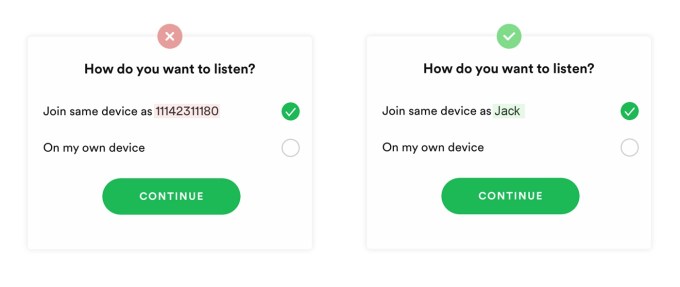In July last year, Spotify extended its shared-queue feature, Group Session, to support remote usage. Essentially a “party mode,” the feature offers a way for participants to contribute to a collaborative playlist in real-time and control what’s playing across everyone’s devices.
As TechCrunch’s Sarah Perez explained, Premium users are able to tune into the same playlist or podcast together at the same time, even if they’re not in the same place. Prompted by the coronavirus pandemic, Spotify, like a spew of other tech companies, is trying to create more shared online experiences that are lockdown-proof, and as people are being forced to spend more time indoors and online.
In our latest UX teardown, with the help of Built for Mars founder and UX expert Peter Ramsey, we highlight some of Spotify Group Sessions user experience failings and offer ways to fix them, as well as a number of UX features that are done right. Many of these lessons can be applied to other existing digital products or ones you are currently building, including the need to remember the difference between usernames and display names, when it makes sense to combine common actions into one, and how to use “react and explain” on-boarding.
Usernames and display namesAlways remember the difference between user names and displays.
Image Credits: Built For Mars
The fail: If you created a Spotify account using Facebook, then you’re arbitrarily assigned an 11-digit display name. This is then shown to everyone you invite and is totally meaningless.
The fix: Prompt the user to set a real display name when they create their first session. It avoids confusion and creates a more real experience.
Steve O’Hear: This looks really sloppy and unprofessional, as well as being useless from a usability point of view. However, I’m guessing this is technical debt of some kind; any idea what’s going on here?
Peter Ramsey: Yes, it happens when usernames go from being irrelevant (i.e., Spotify) to suddenly relevant (i.e. when they add social features). But by that point, the database/infrastructure is already in motion.
Can you think of an example where this has been done right?
Twitter is the perfect example of this done right. There can only be one @jack, but loads of people with the display name Jack. Otherwise basically every tweet would be by some obscure name and the world would feel like Reddit (i.e., anonymous).
Combining common actions into one